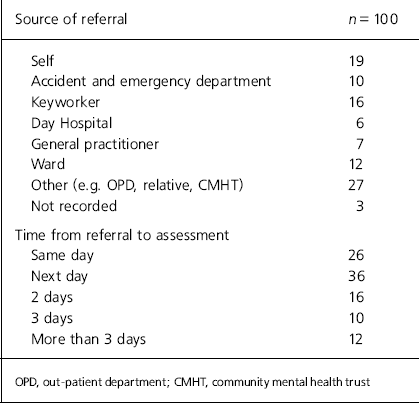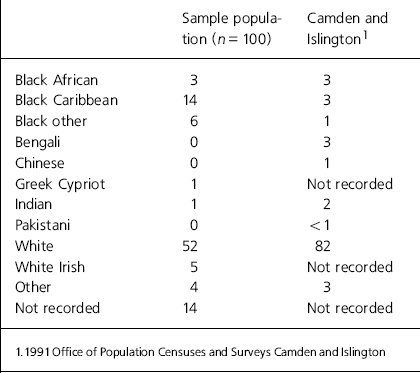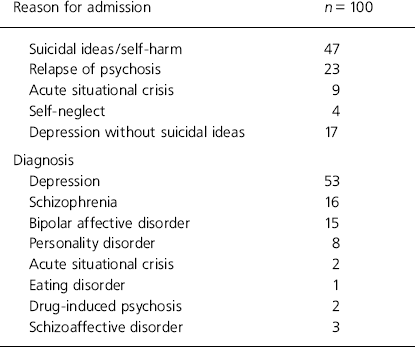Drayton Park is the first women only residential mental health crisis facility in the UK, providing 12 places for women who would otherwise be considered for hospital admission. It also has the unique advantage of offering places for the women's children to remain with them during their stay, thus avoiding the need for temporary placement elsewhere.
The planning of Drayton Park has taken into account two areas of need highlighted as important in the development of mental health services. Some authors have recommended that supported residential facilities should be developed in the community for patients in acute crisis, providing an alternative to in-patient hospital admission (Reference Davies, Presilla and StrathdeeDavis et al, 1994). This may be less personally and socially dislocating for some people with serious mental illness and it may also be of particular value in the inner city where psychiatric morbidity is high, bed occupancy excessive and dissatisfaction with conditions on acute wards is increasing (MilMIS, 1995). There is some evidence from the USA that the crisis house model can be successful (Reference Bedell and WardBedell & Ward, 1989; Reference Fenton, Mosher and HerrellFenton et al, 1998) and although the idea has received support from user groups (Reference Sayce, Christie, Slade, Phelan, Strathdee and ThornicroftSayce et al, 1995) the development and evaluation of such services in the UK has been limited.
There has been recent recognition that women in acute mental distress may be poorly served by existing mental health facilities where there is a lack of privacy, assaults are common and the atmosphere highly aroused (MilMIS, 1995). Female patients' vulnerability to sexual harassment and assault has been highlighted by Henderson & Reveley (Reference Henderson and Reveley1996) and by Mind's ‘Stress on Women’ campaign (Reference Sayce, Abel, Buszewicz and DavisonSayce, 1996). Admission to mixed wards is particularly appropriate for women from some ethnic or religious backgrounds where segregated living is prescribed. Many women admitted to psychiatric wards have experienced childhood sexual abuse or domestic violence and their vulnerability on the ward is especially worrying.
For women with children acute admission to the psychiatric ward means that alternative child care arrangements have to be made, often at short notice and sometimes involving placement of the children in the care of social services. For these reasons the idea of a women-only crisis unit which could provide a safe place for those who would otherwise require hospital admission and which could provide facilities so that children remain with their mothers was developed.
History
In 1993 Camden and Islington Community NHS Trust agreed to bid for funding for the development of an alternative facility for women using psychiatric in-patient services. A researcher was employed for one year to gather information from projects elsewhere in the country offering alternative approaches to mental health crisis management which, along with the views of users and local mental health professionals led to the development and opening of Drayton Park in December 1995. Funding for the first 18 months was provided by the London Implementation Group and subsequently by Camden and Islington Health Authority and the London Boroughs of Camden and Islington. The project benefits from a Management Advisory Group whose members include users, mental health professionals and voluntary agency representatives.
Description
The house itself is a double-fronted Victorian property in a residential street in North London. Accommodation is arranged over four floors with communal areas, group and interview rooms and a staff office on the lower two floors and 12 single-bedded rooms with en suite facilities upstairs. The all-female staff team consists of the project manager, 17 project workers, an administrative assistant and a cook. Considerable efforts have been made to recruit staff from different ethnic groups to reflect the diversity of the local community, though this policy has been difficult to implement because of recruitment problems. Staff come from a variety of professional backgrounds including nursing, social services and other residential projects. A local general practitioner (GP) provides sessional input to the project.
Drayton Park is able to accommodate up to four children over six months in age with a maximum of two children per woman. Child care remains the responsibility of the woman, but up to three two-hour crèche sessions per week are provided to enable attendance at group or individual sessions. Social services children and families teams are informed when any child stays at Drayton Park.
Referrals are taken by telephone from the women themselves, GPs, mental health professionals and carers. Following referral a decision is made as to whether to proceed to assessment and this takes place at Drayton Park and is carried out by a project worker. At assessment there is a thorough exploration of the current situation, the woman's mental state and her level of risk. Women who are considered to be at current risk of violent behaviour, who are misusing drugs or alcohol such that they require detoxification under medical supervision or who are unable to engage in a safety plan and therefore need constant supervision are not offered a place. On admission every woman is allocated two named workers with whom she will plan her care within the framework of the Care Programme Approach. Some women are already known to mental health services and will have community-based keyworkers who remain involved with their care. If women are new to the service then a decision is made as to whether a community-based keyworker needs to be allocated, in which case a referral is made to the sector community mental health team.
The women admitted to the project are temporarily registered at a local general practice which provides a 24-hour medical cover, and a sessional GP visits the project three times a week to see women at the staff's request. Any change in medication can be discussed with the women's own GP or psychiatrist and psychiatric advice and assessment is provided by the women's own sector community mental health team if required. The project has a target of a maximum stay of 28 days. The work done at the house is focused on identifying and resolving the triggers to crisis using a systemic approach based on the model used in family therapy. A variety of interventions are used, involving group and individual work, medication and various complementary therapies including homeopathy, acupuncture and massage. Particular efforts are made to maintain supportive community links where they exist and to identify and strengthen the woman's own coping strategies. Throughout their stay women are encouraged to take an active part in resolving their situation including self-medication as soon as possible. The ethos of the project is to reduce unnecessary reliance on staff.
The study
We randomly selected a sample of case files of women admitted to Drayton Park since its opening. Alternate files were selected until 100 files had been examined. A structured data sheet was filled in on each of the selected files. Since the sample size was 100 the frequencies are equivalent to percentages.
Findings
In the first three years of operation there have been 620 admissions and 44 children have stayed at Drayton Park. During that time one woman has committed suicide while staying at Drayton Park and there have been two suicides shortly after discharge. There have been two episodes of damage to property and no major violent incidents.
In our sample population we found that referrals came from a wide variety of sources and the majority of assessments took place within 24 hours (see Table 1). The ethnic breakdown is given in Table 2. The mean age was 39 years (range 20-72, median 37). The average length of stay was 19 days (range 1-50) and 19 women were given extensions beyond the four week target. The most common reason for admission was suicidal ideation and/or self-harm (47%) followed by relapse of psychosis (23%). The most common diagnosis was depression (53%) followed by schizophrenia (16%) and bipolar disorder (15%). Further details are given in Table 3. Six women were recorded as misusing alcohol or drugs in addition to their primary diagnosis. Eighty per cent of the women were previously known to psychiatric services and 78% had at least one previous admission to a psychiatric unit. Sixty-five women saw a doctor during their admission and of these 10 (15%) saw their sector doctor, 50 (77%) saw the house GP, four (6%) saw their own GP and one (2%) saw a doctor in casualty.
Table 1 Source of referral and time to assessment

| Source of referral | n = 100 | |
|---|---|---|
| Self | 19 | |
| Accident and emergency department | 10 | |
| Keyworker | 16 | |
| Day Hospital | 6 | |
| General practitioner | 7 | |
| Ward | 12 | |
| Other (e.g. OPD, relative, CMHT) | 27 | |
| Not recorded | 3 | |
| Time from referral to assessment | ||
| Same day | 26 | |
| Next day | 36 | |
| 2 days | 16 | |
| 3 days | 10 | |
| More than 3 days | 12 | |
| OPD, out-patient department; CMHT, community mental health trust | ||
Table 2 Ethnic group breakdown

| Sample population (n = 100) | Camden and Islington1 | |||
|---|---|---|---|---|
| Black African | 3 | 3 | ||
| Black Caribbean | 14 | 3 | ||
| Black other | 6 | 1 | ||
| Bengali | 0 | 3 | ||
| Chinese | 0 | 1 | ||
| Greek Cypriot | 1 | Not recorded | ||
| Indian | 1 | 2 | ||
| Pakistani | 0 | <1 | ||
| White | 52 | 82 | ||
| White Irish | 5 | Not recorded | ||
| Other | 4 | 3 | ||
| Not recorded | 14 | Not recorded | ||
| 1. 1991 Office of Population Censuses and Surveys Camden and Islington | ||||
Table 3 Reason for admission and diagnosis

| Reason for admission | n = 100 | |
|---|---|---|
| Suicidal ideas/self-harm | 47 | |
| Relapse of psychosis | 23 | |
| Acute situational crisis | 9 | |
| Self-neglect | 4 | |
| Depression without suicidal ideas | 17 | |
| Diagnosis | ||
| Depression | 53 | |
| Schizophrenia | 16 | |
| Bipolar affective disorder | 15 | |
| Personality disorder | 8 | |
| Acute situational crisis | 2 | |
| Eating disorder | 1 | |
| Drug-induced psychosis | 2 | |
| Schizoaffective disorder | 3 | |
Comment
Initial indications from these data are that the women admitted to the project are suffering from severe and mental health problems and a substantial number have had previous contact with mental health services. The low rate of serious incidents seems to show that Drayton Park is able to provide a safe environment for those presenting in acute crisis. We have no accurate indicator of the severity of symptomatology at admission, but the reasons given for admission appear to be similar to those which precipitate admissions to acute in-patient units. In an emergency situation where use of the Mental Health Act was deemed necessary, Drayton Park could not be considered as an alternative to the acute ward. However, 78% of referrals who were admitted to Drayton Park were seen within 48 hours and the project is, therefore, a viable resource for service users in acute psychiatric crisis. It also appears to be able to manage women in crisis within a relatively short length of stay. There are some interesting differences in the ethnic makeup of our sample population as compared with the local community. For example, we found an over representation of African—Caribbean women and fewer Asian women in our sample as compared with the local population. Future service planning needs to take this into account.
Drayton Park has succeeded in its aim of providing safe alternative to hospital admission for those who experience acute mental distress and admits women with severe mental health problems. The involvement of service users in the planning and management advisory group has helped the project to incorporate an alternative approach to crisis resolution and its innovative style has aroused both national and international interest. Future evaluation of this service including the unique facility it offers to women with children is planned.
Acknowledgement
We would like to thank all the staff at Drayton Park for their help with this study.






eLetters
No eLetters have been published for this article.